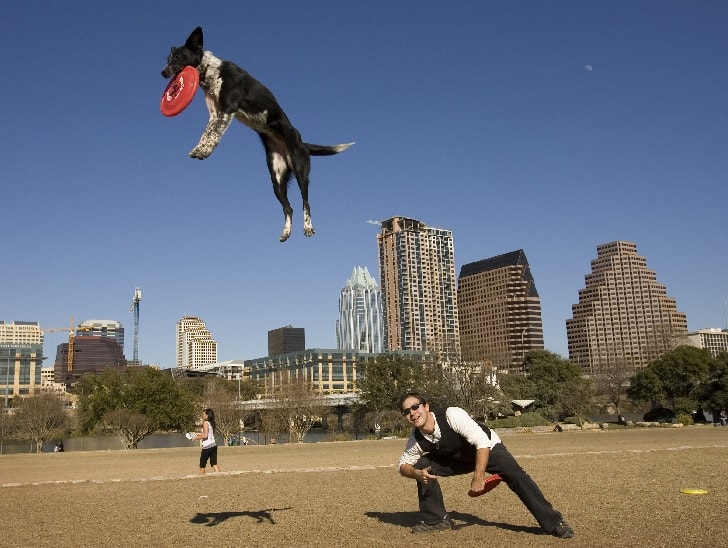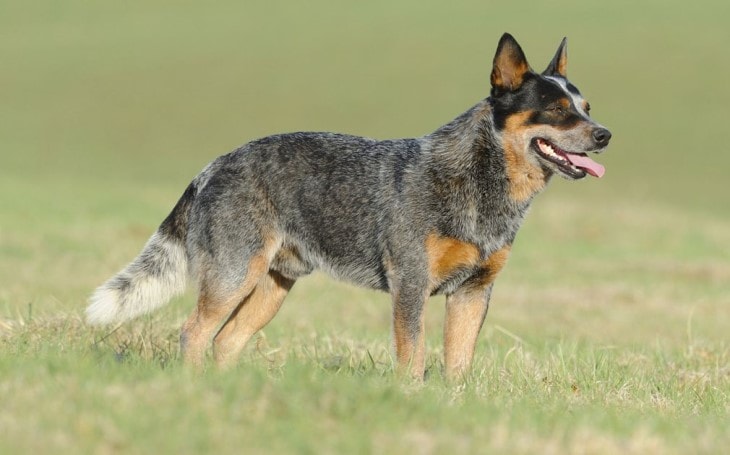Australian Cattle Dog Breed Information
General Information
| Dog Name | Australian Cattle Dog |
|---|---|
| Other Names | Cattle Dog |
| Scientific Name | Canis lupus familiaris |
| Breed Type | Heeler |
| Group | Herding |
| Extinct | No |
| Country of Origin | Australia |
Physical And Size
| Min Life Span | 12 |
|---|---|
| Max Life Span | 16 |
| Min Ideal Weight for male | 15 |
| Max Ideal Weight for male | 20 |
| Min Ideal Weight for female | 13 |
| Max Ideal Weight for male | 20 |
Ranking
| Intelligent Rank | |
|---|---|
| Trainability | |
| Playfulness | |
| Affection Level | |
| Social Needs | |
| Barking | |
| Watchdog Ability | |
| Territorial | |
| Mouthiness | |
| Adaptability |
Characterisitics
| Temperament | Alert, Protective, Loyal |
|---|---|
| Prey Drive | Yes |
| Fighting Dog | No |
Friendliness
| Stranger Friendly | Medium |
|---|---|
| Child Friendly | Medium |
| Cat Friendly | Medium |
| Apartment Friendly | Low |
| Senior Citizens Friendly | Low |
| Service Dog | Low |
| Search and Rescue Dog | Low |
| Biting Potential | Medium |
| Country of Origin | Australia |
| Nicknames and Other Names | Cattle Dog, Queensland Heeler, ACD, Red Heeler, Blue Heeler |
| Scientific Name | Canis lupus familiaris |
| Breed Type | Heeler |
| Group | Herding |
| Bred For | Herding Cattle |
| Size | Medium-sized |
| Recognized By | UKC, NZKC, FCI, AKC, CKC, KC (UK), ANKC |
| Life Span | 12-16 years |
| Ideal Weight | 35-50 pounds |
| Ideal Height | 18-20 inches (male) 17-19 inches (female) |
| Fur Type | Short |
| Common Colors | Red Speckled, Blue, Red Mottled, Blue Mottled, Blue Speckled |
| Markings | Tan Markings, Red Markings, Black &Tan Markings |
| Availability | Easily Available |
| Achievements | Guinness World Record For Oldest Dog |
| Suitable for Apartments | No |
| Used in World War | No |
| Most Similar To | Australian Shepherd |
With a strong head slightly curved, The Australian Cattle Dog Breed is often known as Blue Heeler or Queensland Dog named after a state in its native Australia. They are extremely intelligent, active and sturdy dog breeds still used herding dogs.
Beside the herding works, the canine thrives into sports such as agility training, obedience training, flyball,
Origin And History
The Australian Cattle dogs were bred during the 19th century by Australian settlers to herd cattle. These breeds helped expand the Australian beef industry by herding wild cattle with nip and bites.
But today’s Australian Cattle dogs are the result of many crossbreeding. Ranchers wanted the breed who could work on the harsh climate of Australia. After countless breeding by several ranchers finally resulted what’s believed to be the ancestors of today’s Australian Cattle Dogs.
Are Children Safe Around Australian Cattle Dog?
Yes! children are absolutely safe with the Australian Cattle Dogs. They are fabulous playmates for kids. However, they should be trained on how to approach the children since they are big and rough, might hurt and bite the kids unintentionally.
Not only the dogs, but you should teach your children too on how and when to approach a dog. Teach your child not to bother them while eating and should avoid pinching, pushing and pulling. They may get irritated and aggressive.
Behavior Traits of Australian Cattle Dogs
The Australian Cattle Dogs are extremely alert, intelligent, watchful and courageous breed. They are very loyal to their owners and wary of strangers. The Australian Cattle dogs are not barkers but are fiercely protective watchdogs. If you choose to add Australian Cattle dogs, then be ready to give him enough time and make it tired. If not, it may be destructive when bored and chew things.
Temperament is affected by numerous factors such as heredity, socialization, and training of the Australian Cattle Dogs. Do not choose the puppy who is hiding in the corner or who is aggressive and beating up its littermates. Those factors too can affect the puppy when he’s grown up. Always choose a puppy who is playful and willing to be held by people.
Trainability
Australian Cattle dogs are strong, independent and tend to be stubborn at times. These dogs need consistent leader otherwise they become dominant and try to rule the roost. The training should be started at an early age to develop leadership in the canine. Being bred herd dogs, these dogs are something to watch when they’re working.

Facts About Australian Cattle You Didn’t Know
- The Australian Cattle dogs are crosses between the Dingos and the Blue Merle Collies.
- An Australian Cattle dog named Bluey survived till 29 years of age and chased sheep for almost 20 years. He was born in 1910 and died in the year 1939.
Health Issues
| General Health | Healthy | |
| Common Health Issues | Joints problems, Cataracts, Progressive Retinal Atrophy, Deafness | |
| Hypoallergenic | No | |
| Vaccination Required | Rabies, Canine Distemper, Canine Parvovirus, Kennel Cough, Leptospirosis, Canine Parainfluenza, Canine Coronavirus | |
| Shedding | Moderate Shedding | |
| Drooling | Low | |
| Grooming | Easy and minimal required | |
| Weight Gain Potential | Average to High | |
| Separation Anxiety | Average Chance | |
| Allergies | None | |
| Diets and Supplements | Protein- 18% Fat- 5% Glucosamine Suppliments |
Australian Cattle dogs have the lifespan of about 10-13 years. Some major health problem in Australian Cattle dogs include:
Progressive Retinal Atrophy (PRA)
This is an eye disease that involves the gradual deterioration of the retina. In the early stage of the disease, it may cause night blindness in the dog and may lose eye sight during the day when the disease progresses.
Deafness
This is the inherited in the Australian Cattle Dog, but it can be tested when the puppies are young. As per the research, deafness is a color linked gene that causes the puppies to born white or the hairs in the coat with pattern.
Color Patterns of Australian Cattle Dogs
- Blue
- Red Speckle
- Blue And Black
Australian Cattle Dogs Puppies
The cost of Australian Cattle puppies is somewhere around $600-$800. An average of 5 litter are born at a time.
Which Dog Breed Are They Similar To?
Australian Cattle dogs are similar to:
- Australian Shepherd Dog
- Australian Kelpie
- Working Kelpie
- Australian Terrier
- Australian Stumpy Tail Cattle Dog
Lastly, despite their muscular and serious looking personality, these dog breeds are lovable and playful when trained properly.
Visit Doglime for more dog breed information and behavior.
Tags











2 thoughts on “Australian Cattle Dog Breed Information”